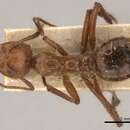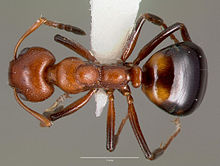fi
nimet breadcrumb-navigoinnissa


Formica , pt., Fabr. Syst. Ent. 394 (1804).
Dolichoderus , Lund. Ann. des Sc. Nat. xxiii. (1831).
This genus has been accepted as containing several subgenera but it appears that generic rank is indicated for certain of these. In the New World, at least, Dolichoderus , Monacis , and Hypoclinea appear distinct as good genera. The Indo-Australian forms probably can be split into several good genera along approximately the present subgeneric lines. The best provisional treatment would be that of according generic rank to all present subgenera. Dolichoderus (s. str.) appears the most distinct of all these groups and possibly the most primitive. Specialists in the Indo-Australian fauna can best decide for the present what the status of their part of the fauna is to be, but it does not seem logical to involve any of the Old World forms with any group occurring in the New World except Hypoclinea .
Dolichoderus is a genus of ants found worldwide.
The ants of the Neotropical genus Monacis were revised in 1959 by Kempf. However, Brown in 1973 and G. C. Wheeler and J. Wheeler in 1973 and 1976 considered both Monacis and Hypoclinea to be junior synonyms of Dolichoderus.[3]
The type species is Dolichoderus attelaboides. Worker ants in this genus have a body length that is typically about four millimetres and can be recognised by their thick, inflexible and strongly sculptured integument. There is a flange on the underside of the head near the base of the mandibles which is saw-like in some species. The longitudinal suture in the central plate of the metathorax is deeply impressed. The propodeum or first abdominal segment has the posterior face distinctly concave when viewed from the side.[4] The gaster and alitrunk are separated by a single segment, the petiole. The orifice of the cloaca is a horizontal slit rather than a circular opening. It is surrounded by a few rather stiff erect bristles.[5]
Members of this genus are found worldwide, in all the continents except Antarctica.[4]
Colonies are of varying sizes and are constructed in the soil, in curled leaves, in the hollow stems of plants and in cartons which are formed by the ants chewing wood and mixing the product with secretions in a similar way to that used by wasps to build their nests. Some species are very versatile with Dolichoderus pustulatus nesting underground in northern parts of the United States while living wholly in trees in the south.[5] The workers seek out and tend sap-sucking insects such as aphids and scale insects that excrete honeydew and they also feed on small arthropods. Some species emit a pungent smelling fluid. Two species, Dolichoderus plagiatus and Dolichoderus taschenbergi, are believed to be polygynous with several queens in one nest. It is also possible that D. taschenbergi may be a temporary social parasite with D. plagiatus as host.[4]
Dolichoderus es un género de hormigas, familia Formicidae. Se distribuyen por todo el planeta, excepto la Antártida, Groenlandia y el sur de África.[2]
Se reconocen las siguientes:
Dolichoderus es un género de hormigas, familia Formicidae. Se distribuyen por todo el planeta, excepto la Antártida, Groenlandia y el sur de África.
Dolichoderus est un genre d'insectes hyménoptères de la famille des Formicidés (fourmis) et de la sous-famille des Dolichoderinae, dans la tribu des Dolichoderini.

Le genre est présent sur plusieurs continents et principalement tropical[1]. Les ouvrières sont de taille moyenne et plutôt lente par rapport aux autres Dolichoderinae[2].
Dolichoderus est un genre d'insectes hyménoptères de la famille des Formicidés (fourmis) et de la sous-famille des Dolichoderinae, dans la tribu des Dolichoderini.
Dolichoderus is een geslacht van mieren, en het typegeslacht van de onderfamilie Dolichoderinae.
Dolichoderus is een geslacht van mieren, en het typegeslacht van de onderfamilie Dolichoderinae.
Dolichoderus é um gênero de insetos, pertencente à família Formicidae.[1]
Dolichoderus é um gênero de insetos, pertencente à família Formicidae.
Долиходерус[6] (лат. Dolichoderus Lund, 1831[7]) — род мелких муравьёв подсемейства долиходерины. Более 150 видов[8].
Большинство видов представлены в тропиках и субтропиках большинства континентов. В фауне России и сопредельных стран встречается 2 вида.[9] Большинство видов обитает в Неотропической (более 60 видов), Ориентальной (56) и Австралийской (около 30 видов) областях (в Неарктике 4 вида, в Палеарктике — 3), а в Афротропической области они вообще отсутствуют (Bolton, 1995).[10]
Длина 2-10 мм, как правило, древесные муравьи коричневато-чёрного цвета. Стебелёк между грудкой и брюшком состоит из одного членика петиолюса, жало отсутствует[9][10]. Большинство видов строят свои гнёзда в древесине, однако есть исключения. Рабочие муравьи полукочевого малайзийского вида Dolichoderus tuberifer переносят своих червецов (Malaicoccus khooi, Pseudococcidae) на новые «пастбища» и не строят муравейники, а образуют некое подобие бивуака дорилин из собственных тел[11] Представители видовой группы Dolichoderus cuspidatus group (12 видов, Юго-Восточная Азия) отличаются полукочевым образом жизни. При этом они перемещают на новые растения своих симбиотических червецов (Allomyrmococcini, 10 родов и 25 видов, Malaicoccus), отчего получили название «Herdsmen ants» (пастухи). Сходный образ жизни обнаружен также у представителей видовой группы D. thoracicus group (D. affinis, D. butteli, D. thoracicus), у группы D. sulcaticeps group (D. crawleyi, D. patens, D. semirugosus, D. sulcaticeps); и у группы D. scabridus group (D. indrapurensis)[12]. Исследованные колонии Dolichoderus cuspidatus включают более 10 000 муравьёв, 4000 куколок и личинок, 5000 червецов, 1 эргатоидную матку. Крылатые самцы наблюдались в большом количестве в сухой сезон (январь-февраль) и в период дождей (сентябрь-октябрь). Размножаются почкованием семей. Гнёзда их представляют типичный бивуак из скреплённых друг с другом живых рабочих муравьёв, покрывающих своими телами расплод и червецов. Располагается такой бивуак-гнездо на листьях, в пустотах древесины и почвы[13].
Более 150 видов, включая около 50 ископаемых. По числу видов известных в ископаемом состоянии этот род занимает первое место среди муравьёв, превосходя по разнообразию все другие роды муравьёв. Самый древний представитель рода D. kohlsi описан из среднего эоцена США.[10]
Некоторые представители рода занесены в региональные Красные книги. Например, Dolichoderus quadripunctatus включён в Красные книги Рязанской области[17] (3-я категория, редкий вид, 2010) и Днепропетровской области (2011)[18].
Долиходерус (лат. Dolichoderus Lund, 1831) — род мелких муравьёв подсемейства долиходерины. Более 150 видов.